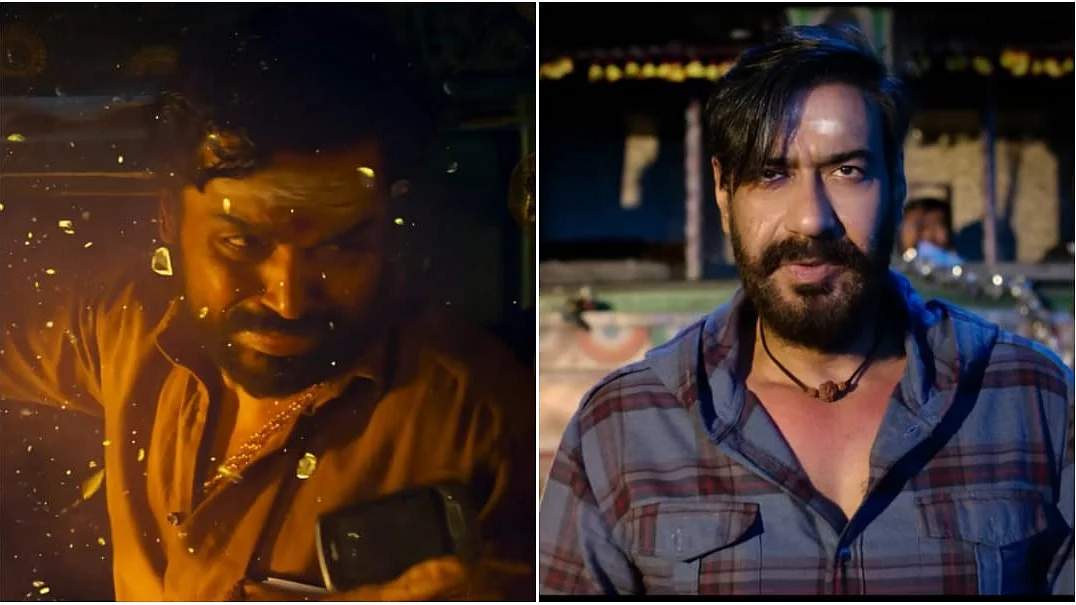Here Are 5 Aspects That Distinguish Ajay Devgn's 'Bholaa' From Karthi's 'Kaithi'
Ajay Devgn's 'Bholaa' is the official Hindi remake of the 2019 Tamil blockbuster 'Kaithi' starring Karthi.

advertisement
Ajay Devgn's fourth directorial project, Bholaa, hit the silver screens on 31 March. While the film is the official Hindi remake of Lokesh Kangaraj's 2019 Tamil blockbuster Kaithi starring Karthi, it is not entirely a frame-by-frame copy of the original.
Here's how Bholaa is different from Kaithi:
1. Bholaa Vs Dilli
One of the biggest differences between the two films is the backstory of their lead characters. Karthi, who plays Dilli in Kaithi, describes himself as a rowdy alcoholic whose life came back on track thanks to Viji, his love interest. The couple started living happily near the train station until one day some criminals tried to kidnap a pregnant Viji, and Dilli murdered them all. This becomes the reason for Dilli's 10-year-long imprisonment.
Ajay Devgn in a still from Bholaa; Karthi in a still from Kaithi.
(Photo Courtesy: YouTube)
Bholaa, on the other hand, is a gangster who abandons his criminal behaviour after falling in love with Amala Paul's character. As shown in the film's flashback, Abhishek Bachchan's mysterious character abducts Bholaa's wife and sends him to prison.
While Dilli's backstory was narrated in Kanagaraj's Kaithi, it has been visualised in Devgn's Bholaa. Kaithi, however, didn't go into details about its protagonist's past, which Bholaa utilised to drive the plot to a cliffhanger towards the end.
2. IPS Diana Joseph & Inspector Bejoy
In Kaithi, Narain plays Inspector Bejoy. Whereas in Bholaa, the same character is portrayed by Tabu (IPS Diana Joseph). Though there are quite a few similarities between the two characters, but the decision to introduce a female character into an already male-centric film seemed like an unnecessary adjustment when it wasn't even an empowering role.
Tabu in a still from Bholaa; Narain in a still from Kaithi.
(Photo Courtesy: YouTube)
In one of the fight scenes, Tabu is manhandled by a mob since she is unable to defend herself after being shot in the shoulder. In the same scenario, Bholaa, who has been stabbed in the gut and punched several times, is able to take down all of them alone, using both logic and gravity-defying stunts.
While Narain had well-written dialogues to work with in Kaithi, Tabu's were barely enough. Some other changes include the police officers' daughters; while Bejoy's was alive, Diana's was a stillborn.
3. The Music
Despite all the misogyny associated with "item" numbers, they exist in commercial Indian films even today. Another factor that differentiates Bholaa from the Kanagaraj directorial is the inclusion of the same.
Starring Raai Laxmi opposite Deepak Dobriyal, 'Paan Dukaniya' arrives at an integral point in the film, which helps take Bholaa's journey forward.
A still from 'Paan Dukaniya'.
(Photo Courtesy: YouTube)
Kaithi, on the other hand, has no such dance numbers. The film's background score, directed by Sam CS, is a low-key theme music that fits the demands of the various situations in the film almost perfectly. In contrast, the background score in Bholaa is so poorly mixed that even dialogue-heavy scenes lose their impact as nothing can be heard besides Ravi Basrur's loud score.
4. Action Sequences
Both Kaithi and Bholaa are filled with action sequences. Except for a few scenes, both films have similar action scenes that differ greatly in their on-screen presentation. While Kanagaraj's film focuses more on the choreography of its adrenaline-pumping stunts, Devgn's directorial relies more on VFX and CGI.
Ajay Devgn in a still from Bholaa; Karthi in a still from Kaithi.
(Photo Courtesy: YouTube)
Unlike Kaithi, the remake has several additional action sequences. In one of the scenes, Bholaa gets into a fight with some acrobatic bikers, which uses the film's visual effects to its full strength. Another scene features a bunch of goons accompanied by a CGI-powered leopard.
While both Dilli and Bholaa are shown as devotees of Lord Shiva, Devgn's direction is heavy on the deity's iconography and symbolism. Another action sequence from Bholaa features Devgn's character fighting off multiple villains with a trident (Trishul) with ashes smeared on his forehead, against the backdrop of a massive Lord Shiva idol.
A still of Ajay Devgn from Bholaa.
(Photo Courtesy: YouTube)
5. The Usage of Colour
Stills from Bholaa and Kaithi.
(Photo Courtesy: YouTube)
Devgn's Bholaa and Kangaraj's Kaithi have an obvious colour palette difference. While Kaithi employs a lot of undertones of blue, Bholaa uses more vibrant tones of the same colour. Unlike Kaithi, Bholaa has a darker undertone, which also restricts the audience base it may have appealed to. Another justification for the usage of the mythical blue colour could be its significance to Lord Shiva, who is portrayed blue in Hindu mythology.
In contrast to Devgn's Bholaa, Kaithi is more realistically balanced in terms of colour.
(At The Quint, we question everything. Play an active role in shaping our journalism by becoming a member today.)